
december 30, 2023 | 3 Mins Read
TABLE OF CONTENTS
1. What is Achilles Tendonitis?
2. Are Compression Socks Good for Achilles Tendonitis?
3. How Long to Wear Compression Socks for Achilles Tendonitis Recovery?
4. What is the Best Compression Level for Achilles Tendonitis?
5. How Long Does Achilles Tendonitis Take to Recover With Compression Socks?
6. How to Wear Compression Socks for Achilles Tendonitis Recovery?
7. Are There Any Side Effects of Wearing Compression Socks for Achilles Tendonitis?
8. What Other Treatments Can You Do to Improve Achilles Tendonitis Recovery?
9. When To See a Doctor for Achilles Tendonitis?
10. How to Choose the Best Compression Socks for Achilles Tendonitis?
Are you tired of the constant pain and discomfort caused by Achilles tendonitis? Do you find it challenging to engage in your favorite activities due to this condition? If so, you're not alone. Achilles tendonitis is a common overuse injury that affects many individuals, causing pain and inflammation in the back of the lower leg.
Fortunately, there is a solution that can help alleviate the symptoms and promote healing – compression socks.

Achilles tendonitis is a condition marked by inflammation and irritation of the Achilles tendon, the thick band of tissue that links the calf muscles at the back of the lower leg to the heel bone. This ailment typically arises from overusing the tendon, making it common among people who participate in activities that place a lot of stress on this tendon, such as running. It often affects runners who suddenly increase the intensity or duration of their running sessions, leading to excessive strain on the tendon. This increased activity can cause the tendon to become inflamed, resulting in pain and discomfort in the affected area.
Understanding the causes of this condition is crucial for prevention and effective treatment. Let's delve into the various factors that contribute to the development of Achilles tendinitis.
Achilles tendonitis results from a combination of physical activities, individual anatomical factors, age-related changes, and underlying health conditions. Understanding these factors can help in both preventing and effectively treating this condition.
Compression socks can provide support and aid in injury recovery, including calf strains and sprained ankles. Athletes, in particular, may benefit from Achilles tendon compression socks during their recovery period, as they can help prevent additional injuries such as Achilles tendonitis.
By providing stability and promoting proper alignment, compression socks contribute to improved proprioception, reducing the risk of overexertion and further damage to the Achilles tendon.
Here are some of the key benefits offered by compression socks for Achilles tendonitis:
However, it's important to remember that compression socks are just one aspect of the overall treatment and recovery plan.
A comprehensive approach that combines the use of compression socks with appropriate treatment and preventive strategies is essential for optimizing recovery from Achilles tendonitis.

In the recovery process from Achilles tendonitis, the use of compression socks plays a crucial role across different phases, each with specific objectives and timelines. Initially, in the first 2 weeks, the focus is on reducing inflammation and managing pain. Here, compression socks are vital for decreasing swelling and enhancing blood flow, which accelerates healing and alleviates discomfort. As recovery progresses into the intermediate phase (2-6 weeks), the aim shifts to gently increasing mobility and strength, while being cautious not to overstrain the tendon. Compression socks continue to be beneficial during this stage by providing gentle support to the Achilles tendon, thus preventing excess swelling as movement is reintroduced. They also maintain improved circulation, critical for tissue repair.
In the advanced phase (6-12 weeks), the recovery involves more active rehabilitation exercises to restore full strength and flexibility. At this juncture, compression socks offer additional support to the Achilles tendon, crucial in reducing re-injury risks as activities and exercises intensify. They still aid in managing swelling and sustaining good blood flow, essential during this active recovery phase. Beyond 12 weeks, the wearing of compression socks can still be beneficial, especially during activities that put strain on the Achilles tendon, as they continue to provide support and improve circulation, aiding in the complete rehabilitation of the tendon.
Expert tip:
Elevate your foot above the heart level when you're sitting or lying in bed to reduce inflammation.
To effectively manage Achilles tendonitis, medical experts suggest using compression gear that applies a pressure of 20 to 30 mmHg. This compression range is not only ideal for supporting the Achilles tendon but also beneficial for other venous issues like edema, swollen feet, and varicose veins. This level of compression provides adequate support without causing discomfort, making it a recommended choice for those suffering from Achilles tendonitis and similar conditions.
The recovery time for Achilles tendonitis when incorporating compression therapy into the treatment plan varies based on several factors. Initially, a period of a few weeks is typically required for noticeable symptom improvement. This phase involves not only the use of compression socks, which provide support and reduce swelling but also includes other critical components of home care. These components are rest, the application of ice to reduce inflammation, and engaging in specific exercises aimed at strengthening and rehabilitating the Achilles tendon. The consistent application of these treatments is essential to manage the pain and swelling associated with tendonitis.
Expert tip:
Wear compression socks first thing in the morning or during the daytime when you are most active.
While using compression socks to treat Achilles tendonitis is generally safe, some users may experience minor side effects, primarily related to skin irritation according to a study. This irritation typically presents as mild redness and itching and is caused by the pressure and friction exerted by the compression material against the skin. These symptoms are usually harmless and can often be mitigated by ensuring the socks fit correctly and are not too tight, which can exacerbate skin irritation.
Expert tip:
Keep the skin clean, dry, and moisturized to reduce friction and irritation.
In addition to wearing Achilles tendon compression socks, there are other treatment options available for Achilles tendonitis. These may include:
It's important to consult a doctor for Achilles tendonitis if certain symptoms persist or worsen, despite home care and the use of compression socks. Key indicators that warrant a medical consultation include:
When selecting the best compression socks for managing Achilles tendonitis, it's essential to consider several key factors to ensure effective relief and support.
Among the various options, Koprez Medical Compression Socks are widely recommended by both customers and medical professionals in and outside the US. They are specially crafted to offer targeted compression and support to the Achilles tendon. This design is beneficial for promoting proper blood circulation, which is crucial for healing, and for reducing swelling and discomfort associated with Achilles tendonitis.
Author

Claire Evans worked as the content marketing manager at Koprez. Claire combined a background of writing and editing, marketing, and patient education to best serve consumers, fitness enthusiasts, athletes, and anyone who relies on the Koprez brand for helpful information.
Koprez® Featured Products